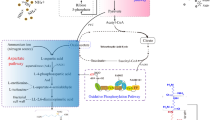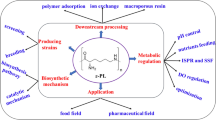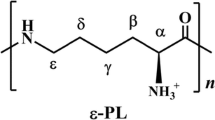Abstract
ε-Poly-l-lysine (ε-PL) is a homo-poly-amino acid characterized by the peptide bond between the carboxyl and ε-amino groups of l-lysine. ε-PL shows a wide range of antimicrobial activity and is stable at high temperatures and under both acidic and alkaline conditions. The mechanism of the inhibitory effect of ε-PL on microbial growth is the electrostatic adsorption to the cell surface of microorganisms on the basis of its poly-cationic property. Due to this antimicrobial activity, ε-PL is now industrially produced in Japan as a food additive by a fermentation process using Streptomyces albulus. In spite of the practical application of ε-PL, the biosynthetic mechanisms of ε-PL have not been clarified at all. ε-PL producers commonly possess membrane-bound ε-PL-degrading aminopeptidase, which might play a role in self-protection.



Similar content being viewed by others
References
Hiraki J (1995) Basic and applied studies on ε-polylysine. J Antibact Antifungal Agents 23:349–354
Hiraki J (2000) ε-Polylysine, its development and utilization. Fine Chem 29:18–25
Hiraki J, Hatakeyama M, Morita H, Izumi Y (1998) Improved ε-poly-l-lysine production of an S-(2-aminoethyl)-l-cysteine resistant mutant of Streptomyces albulus. Seibutsu Kogaku Kaishi 76:487–493
Itzhaki FR (1972) Colorimetric method for estimating polylysine and polyarginine. Anal Biochem 50:569–574
Kahar P, Iwata T, Hiraki J, Park YE, Okabe M (2001) Enhancement of ε-polylysine production by Streptomyces albulus strain 410 using pH control. J Biosci Bioeng 91:190–194
Kito M, Onji Y, Yoshida T, Nagasawa T (2002a) Occurrence of ε-poly-l-lysine-degrading enzyme in ε-poly-l-lysine tolerant Sphingobacterium multivorum OJ10, purification and characterization. FEMS Microbiol Lett 207:147–151
Kito M, Takimoto R, Yoshida T, Nagasawa T (2002b) Purification and characterization of ε-poly-l-lysine-degrading enzyme from an ε-poly-l-lysine-producing strain Streptomyces albulus. Arch Microbiol 178: 325–330
Kito M, Yoshida T, Nagasawa T (2002c) Cloning and analysis of the gene for ε-poly-l-lysine-degrading enzyme of an ε-poly-l-lysine producing Streptomyces albulus. Annu Meet Soc Biosci Biotechnol Biochem Jpn 2002:208
Kuraray Co. (2001) Water swelling polymer gel and its production method. Japan patent 2001-278984
Lipmann F (1980) Bacterial production of antibiotic polypeptides by thiol-linked synthesis on protein template. Adv Microbiol Physiol 21:227–266
Neda K, Sakurai T, Takahashi M, Ashiuchi M, Ohgushi M (1999) Two-generation reproduction study with teratology test of ε-poly-l-lysine by dietary administration in rats. Jpn Pharmacol Ther 27:1139–1159
Nishikawa M, Ogawa K (2002) Distribution of microbes producing antimicrobial ε-poly-l-lysine polymers in soil microflora determined by a novel method. Appl Environ Microbiol 68:3575–3581
Saimura M, Ikezaki A, Takahara M, Hirohara H (2002) Structures of ε-polylysine produced by several actinomycetes and their classification on the basis of productivity of ε-polylysine. Annu Meet Soc Biosci Biotechnol Biochem Jpn 2002:54
Shima S, Sakai H (1977) Polylysine produced by Streptomyces. Agric Biol Chem 41:1907–1909
Shima S, Sakai H (1981a) Poly-l-lysine produced by Streptomyces. Part II. Taxonomy and fermentation studies. Agric Biol Chem 45:2497–2502
Shima S, Sakai H (1981b) Poly-l-lysine produced by Streptomyces. Part III. Chemical studies. Agric Biol Chem 45:2503–2508
Shima S, Fukuhara Y, Sakai H (1982) Inactivation of bacteriophages by ε-poly-l-lysine produced by Streptomyces. Agric Biol Chem 46:1917–1919
Shima S, Oshima S, Sakai H (1983) Biosynthesis of ε-poly-l-lysine by washed mycelium of Streptomyces albulus no. 346. Nippon Nogeikagaku Kaishi 57:221–226
Shima S, Matsuoka H, Iwamoto T, Sakai H (1984) Antimicrobial action of ε-poly-l-lysine. J Antibiot 37:1449–1455
Takagi H, Hoshino Y, Nakamori S, Inoue S (2000) Isolation and sequence analysis of plasmid pNO33 in the ε-poly-l-lysine-producing antinomycete Streptomyces albulus IFO14147. J Biosci Bioeng 89:94–96
Takimoto R, Kito M, Yoshida T, Onji Y, Nagasawa T (2002) Characterization of microbial enzymes catalyzing the degradation of ε-poly-l-lysine. Annu Meet Soc Biosci Biotechnol Biochem Jpn 2002:297
Zocher R, Keller U (1997) Thiol template peptide synthesis systems in bacteria and fungi. Adv Microbiol Physiol 38:85–131
Author information
Authors and Affiliations
Corresponding author
Rights and permissions
About this article
Cite this article
Yoshida, T., Nagasawa, T. ε-Poly-l-lysine: microbial production, biodegradation and application potential. Appl Microbiol Biotechnol 62, 21–26 (2003). https://doi.org/10.1007/s00253-003-1312-9
Received:
Revised:
Accepted:
Published:
Issue Date:
DOI: https://doi.org/10.1007/s00253-003-1312-9




